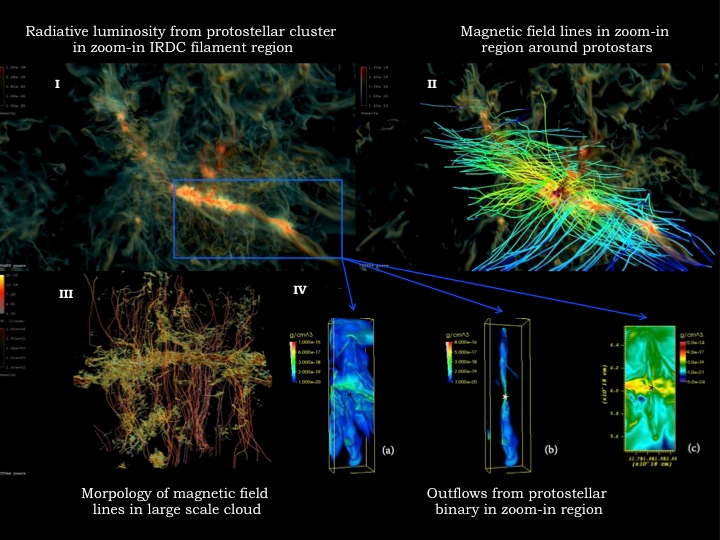| EPoS Contribution |
|
Multi-Physics, Multi-scale Simulations of Star Formation in Filamentary Infrared Dark Molecular Clouds: A Hierarchical Approach from Large Scale Magnetized Clouds to Stellar Clusters
Richard Klein UC Berkeley/LLNL, Berkeley, US | |
|
The origin and formation of stellar clusters remains a fundamental grand challenge in astrophysics. Tackling such a challenge requires complex multi-physics simulations that must include a large range of physical processes, including: self-gravity; supersonic turbulence; hydrodynamics; outflows; radiation and magnetic fields.
However, the high degree of non-linear coupling and feedback mechanisms among these processes, along with the enormous dynamical range in time and spatial scales, make such simulations difficult to produce. In this talk I shall present new simulations that for the first time investigate star formation with fully coupled multi-physics that include feedback from protostellar outflows and radiative transfer traversing the large scales of the ISM (~1 kpc) down to the micro-scales of protostars and clusters.
For the first part of the talk I shall discuss our new large scale, multi-physics simulations using a hierarchical zoom-in AMR approach. Using our 3D adaptive mesh refinement (AMR) code, ORION2, we produce simulations that include magnetic fields, radiation transport, turbulence, and highly energetic protostellar outflows.
These simulations, for the first time, follow the gravitational collapse (over a spatial dynamic range of several decades) of a magnetized, supersonically turbulent, massive molecular cloud through to the formation of dense IRDCs and multiple turbulent clumps inside these IRDCs, which then gravitationally collapse resulting in the creation of star-forming cores.
The magnetized cores are further evolved to form protostars and stellar clusters via AMR zoom-in simulations. Complex filamentary structures emerge naturally from the simulations. Magnetic field lines pierce the dark cloud filaments primarily in the direction normal to the filament axis.
We then perform deep zoom-in simulations into the structure of the main IRDC filament that include the fully coupled physics and continue the simulations to study the formation and properties of a stellar cluster inside IRDCs. I shall discuss the effects of both radiative feedback and protostellar outflow feedback from the protocluster on the surrounding environs and (1) the formation of the resultant IMF and its agreement with the Chabrier IMF, (2) the Proto-stellar Mass function and the Proto-stellar Luminosity function and make detailed comparisons with several theoretical models and with observations, (3) the multiplicity fractions within the cluster and comparisons with observations of Class I protostars, (4) the cluster luminosity and comparisons with observations and finally, (5) the comparison of our proto-stellar outflows with theoretical models and recent observations. We find that the star formation efficiency is super-linear in time ~t2 resulting in a star formation rate that is in good agreement with recent observations. For the second part of the talk I shall present preliminary results that start from a ~500 pc portion of a galactic disk that has been evolved for 380 Million years with conditions comparable to the solar neighborhood in terms of total ISM gas surface density, gravitational potential of the stellar disk, background galactocentric rotation and shear rates and mean magnetic field. Using a hierarchical AMR zoom-in approach, we resolve down to the formation of stars with fully coupled physics spanning a spatial dynamic range of ~1 kpc to 25 AU. | |
 | |
| Caption: The dynamics and evolution of a large-scale turbulent magnetized cloud are followed to the formation of a stellar cluster with Orion2 AMR radiation-magneto-hydrodynamic Zoom-in simulations. In panel (I) after 690,000 years the gravitational collapse of a large magnetized supersonically turbulent cloud has formed an IRDC filament. Within the dense IRDC filament ~ 4 pc in linear scale and with several levels of additional mesh refinement, a protostellar cluster consisting of ~ 40 protostars has formed after 690,000 years. The bright orange yellow regions are the radiative luminosity emitted by the cluster and the individual stars that have formed within the IRDC filaments. The protostars interact with their surroundings with radiation and protostellar outflow feedback supplying radiative heating and momentum to their environs. In panel (II) we see the morphology of the magnetic field lines deep into the zoom-in region and note that magnetic field lines are locally perpendicular to the main filament. In panel (III) we show the global structure of the magnetic field lines throughout the large-scale turbulent cloud and in panel (IV) we show outflows from a proto-stellar binary deep within the zoom-in cluster region: (a) volume rendering of total gas around a collimated outflow from the proto-stellar binary, (b) volume rendering of outflow gas with speed > 5 km s-1 showing the high velocity collimated outflow, (c) density slice through the binary shows the total gas around the outflow. The height of the bounding box is about 0.36 pc. | |
| Collaborators: PS. Li, UC Berkeley, US C.F. McKee, UC Berkeley, US S. Li, UC Berkeley,US C. Safranek-Schrader, UC Berkeley, US M. Krumholz, ANU, AU E. Ostriker, Princeton U, US J. Stone, Princeton U, US C.-G. Kim, Princeton U , US |
Key publication
Suggested Session: Stellar Feedback |

